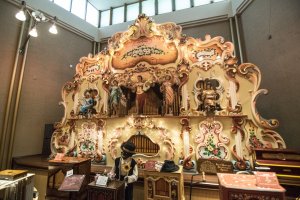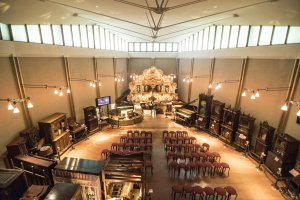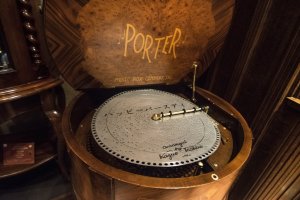If you have no idea what an orgel is, you’re not alone. As it turns out, the orgel is the Japanese term for the wind-up musical box. Written in katakana and read orugōru as though it were a borrowed word; the orgel has no actual equivalent in anglo-lingustics, it is known simply as the music box to the rest of the world.
The Hamanako Orgel Museum curates over 70 different mechanically driven musical boxes from all over the world, every single one intricately built and more astounding than the last. Unlike the small and portable musical boxes, the instruments featured here are typically large, wardrobe-size pieces harkening to a past when such instruments were a luxurious, popular form of entertainment.
To my immense amazement, all of them has been kept in tip-top condition and almost all of them can still play beautiful music. In fact, the Hamanako Orgel Museum is acoustically designed for this purpose, so that visitors can appreciate the rich reverberations and melodious chimes echoing throughout the entire museum.
The centerpiece of the Hamanako Orgel Museum is unmistakably the gigantic 6 meters tall Spanish orgel that sits at the very middle of the hall, dwarfing the rest of the instruments. When played (yes it works!), this fully-automated orgel produces a rich and grandiose timbre that is truly a feast for the auditory senses.
So that the tunes of different orgels do not clash when multiple instruments are played together, the Hamanako Orgel Museum does not allow users to freely operate the musical boxes. Instead, museum has taken the extraordinary step of scheduling performances and demonstrations for the entire duration of opening hours.
A carillon installed above on the observation deck will play a short melody on the hour, every hour. 15 minutes later, curators will play the centerpiece of the museum. On the 25th minute of the hour, a 20 minutes demonstration will be given by the curators on a select few instruments. During this session, the curators explain the history of each orgel, supplemented by a TV monitor and live-camera directed to show the inner workings of the orgel. The instruments on display differ from session to session, and I found myself sitting in for not 1 but 3 explanations, they were simply too interesting to miss.
When visitors are finished exploring the museum, the museum shop situated the floor below stocks over 1,000 different kinds of musical boxes, playing pieces from classical music to the latest Japanese pop. Visitors can also create their own music boxes at the DIY factory at the back of the museum shop.
If you have no idea what an Orgel is, visiting the Hamanako Orgel Museum is a perfect way to find out. Entry to the Hamanako Orgel Museum typical comes together in a combination ticket with the Kanzanji Ropeway, and I compel you to visit on your next trip to Hamamatsu.
Entry to the Hamanako Orgel Museum alone costs ¥820 for adults and ¥410 for children. The combination ticket, providing a return trip on the Kanzanji Ropeway, costs ¥1,450 for adults and ¥700 for children. Discounts of up to ¥200 can be obtained via vouchers readily available at most hotels in Hamamatsu. Hamana-ko is a 40 minutes bus ride on local Entetsu bus No.30 from JR Hamamatsu Station.





































